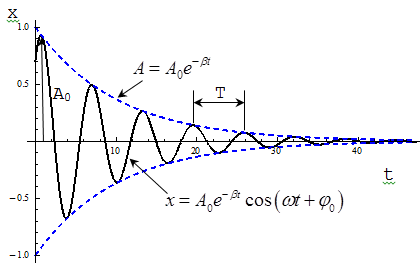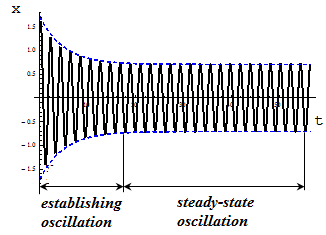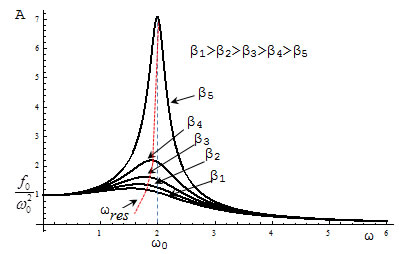main
To the list of lectures
|
§6 Damped oscillations Damping rate. Logarithmic decrement. Quality
Fluctuations with amplitude due to energy losses of real oscillating system decreases over time are called damped. The most common cases where the resistance force is proportional to the velocity of the motion
where r - coefficient of resistance of the medium. The minus sign indicates that the Fr is directed in the direction opposite the velocity. We write the equation of vibrations at the point oscillating in a medium whose resistance coefficient r. According to Newton's second law
where β - coefficient of damping. This ratio describes the rate of damping. In the presence of the forces of resistance the energy of the oscillating system will gradually decrease, the oscillations are damped.
- Differential equation of damped oscillations.
-The equation of damped oscillations. ω –- the frequency of the damped oscillations:
The period of the damped oscillations
Damped oscillations can be considered as harmonic oscillations whose amplitude varies exponentially
In equation (1) A0 and φ0 - arbitrary constants that depend on the choice of the point in time at which we consider vibrations.
Consider the oscillations for at some time τ, for which the amplitude is reduced by a factor e
τ - relaxation time. The damping coefficient β is inversely proportional time, during which the amplitude is reduced by a factor e. However, the damping factor is not enough to describe the damping vibrations. It is therefore necessary to introduce this feature for vibration damping, which includes the time of one vibrations. This characteristic is the decrement (in Russian: decrease) damping D, which is the ratio of the amplitudes, which are separated in time by a period:
Logarithmic decrement is equal to the logarithm of D:
Damping constant is inversely proportional to the number of vibrations that result in decreased amplitude of e. Damping constant - constant for a given system magnitude. Another feature of the system is the vibrational quality factor Q.
Quality factor is proportional to the number of vibrations committed system during the relaxation time τ. Quality factor Q vibrating system is a measure of relative dissipation of energy. Quality factor Q oscillating system is a number indicating how many times the force of elasticity greater resistance forces.
The higher the quality factor, the slower the damping, the damped oscillations close to free harmonic. Resonance
Let
We write the expression for the equation of motion of a particle undergoing harmonic oscillatory motion by the driving force. According to Newton's second law:
- Differential equation of forced oscillations. This differential equation is linear inhomogeneous. His solution is the total solution of the homogeneous equation and a particular solution of the inhomogeneous equation:
We find a particular solution of the inhomogeneous equation. To do this, we rewrite (1) as follows:
The particular solution of this equation sought in the form:
Then
In (2):
because holds for any t, we must have γ = ω, hence
This complex number is conveniently written as
where A is defined by (3 below), and φ - by the formula (4), therefore, the solution (2) in the complex form is
Its real part is the solution of equation (1) is:
Xt h term plays a significant role only in the initial stage of the establishment of
The amplitude of the fluctuating value of the frequency of the driving force is called the resonance curve. Resonance curve will be higher, the lower the damping factor β and decreasing β, the maximum resonance curves mixed right. If β = 0, then ωres = ω0. When ω → 0, all the curves come to value
Parametric resonance occurs when the periodic variation of one of the parameters the system leads to a sharp increase in the amplitude of the oscillating system. For example, the cockpit, making "sun" by changing the position of the center of gravity of the system. (Same as in "boat".) See § 61. T 1 Savelyev I.V. Self-excited oscillations are those vibrations whose energy is periodically updated by the impact of the system due to a power source in the same system. See § 59 v.1 Savelyev I.V. |





